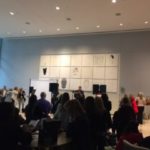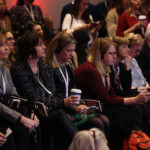National Cattlemen’s Beef Association

From lanterns to giant sand castles, there’s nothing ordinary about the way NCBA incorporates sponsorships into its annual Trade Show.

Nothing feels out of context at the oldest and largest convention for the cattle business. Every breakout session, every decoration, every booth at the Cattle Industry Convention & National Cattlemen’s Beef Association (NCBA) Trade Show is perfectly tailored to the event’s destination. Attendees donned pirate hats and eye patches at the Gasparilla Pirate–themed receptions at this year’s show in Tampa Bay, and enjoyed fresh biscuits and bluegrass music the year before in Nashville.
The immersive environment that NCBA creates not only engages attendees, but also makes it easy to incorporate sponsorship in unusual and eye-catching ways. Sponsors have utilized everything from personal shuttles to light fixtures to sand sculptures of Dolly Parton. “Our goal with those sponsorships is to not only generate revenue for the association,” said Kristin Torres, NCBA’s executive director of meetings and events, “but to overall enhance the attendees’ experience.”
A few years ago, when NCBA was evaluating its show, which draws about 6,200 cattle producers, the organization learned that attendees thought it was “all business and no fun.” NCBA set out to change that. At the 2013 show, held at the Tampa Bay Convention Center from Feb. 6–8, large stickers in the shape of cow hooves led attendees from booth to booth in the exhibit hall. Live music filled the convention center as artists stood ankle-deep in sand, sculpting away at a Bayer Animal Health–sponsored sand castle. The year before in Nashville, the sand artists built busts of iconic country music singers.
That sense of fun carries throughout NCBA’s sponsorship programs. In lieu of banner ads and other typical sponsor collateral, NCBA incorporated signage into the foliage in Tampa Bay, scattering signs among the palm trees in the hotels, and in and around the convention center. Sponsored personal electric carts from Mulligan Shuttle zipped attendees around the city, while sponsored yacht parties were held throughout the three-day event.

Similarly, animal-health company Merial has sponsored a “watering hole” for the past three years — a lounge on the show floor where attendees can escape for drinks and live music. “It’s a win for the sponsor,” Torres said, “because they ultimately get their name associated with that experience.” Merial then passes out free drink coupons at its booth to select attendees. Of course, people don’t just come to NCBA to drink. They come to eat, too. At some booths, they can sample freshly cut beef — straight from farm to fork.
“What we have found,” Torres said, “is that our sponsors are looking to us to be more of an agency to them. We’re becoming more and more like a consultant to them.” NCBA has witnessed a steady increase in sponsorship over the years. “Their demand for ROI is higher, and their demand for creative solutions for what they’re trying to do is higher as well,” Torres said. “So, when we go into a city, we key it up with the bureau and usually our convention center contacts, and say, ‘We need as many unique things that you’ve seen done.’”
In 2014, NCBA will return to Nashville for its 116th convention — and more Southern-inspired fun. “The goal that we aspire to is to create a once-in-a-lifetime experience every day for our attendees,” Torres said. “And so we take that attitude when we’re looking at everything that we do.”

Dwell Media

Powered by the premier architecture and design magazine, Dwell on Design knows how to grab people’s attention, engage their emotions — and make them feel at home.

When you’re standing in the middle of the show floor at Dwell on Design — the largest modern design event in the United States — it’s easy to forget that you’re inside at all. In the center of the exhibition, engulfed in thousands of plants and trees, sits Dwell Outdoors, a 20,000-square-foot space that showcases vignettes of cutting-edge outdoor design, this year including five homes and two airstreams. “My goal is to keep people there all weekend,” Michela O’Connor Abrams, president of Dwell Media, said of the show floor, and “to design a completely immersive experience.”
Instead of a traditional trade-show layout, Dwell divides its annual exhibition — attended by about 30,000 designers and 400 exhibitors, ranging from small-furniture artisans to the Lincoln Motor Company — into “zones of interest and influence,” O’Connor Abrams said. There are also three stages on the show floor for presentations and discussions pertaining to design innovation, sustainable design, and the business of design. To keep people at the show longer, the floor doesn’t close at night. “The lights go down. The bars come up,” O’Connor Abrams said. “We have an award ceremony. We have a grand keynote.” The idea is that “you are coming back and you are bringing colleagues or family or clients,” she said, “and enjoying it because you could not possibly see or participate in everything in one day.”
The planning process for the show — held this year at the Los Angeles Convention Center on June 21–23 — is year-round. “We kick up the innovation and the floor plan to new heights every year,” O’Connor Abrams said. One example: moving Dwell Outdoors from the back of the show floor, where it was last year, to the center of everything. “We decided it was such an important element that we wanted it to be a centerpiece,” she said, “and it provided a great sense of circulation for the attendees.”
Dwell on Design is curated by Dwell magazine editors and intended to reflect the content of the publication; however, that vision has evolved over the years from a literal interpretation of Dwell to something more expansive. “Eight years ago,” O’Connor Abrams said, “we hung big blowups of magazine covers, and it was very much about stepping into a Dwell magazine event.” About five years ago, Dwell magazine became Dwell Media, and the event has changed to reflect that transition. “The voice of Dwell completely and totally informs what it is that we are producing,” she said. “But we really give the live event permission to push the boundaries into areas and subjects that we may not cover in the magazine.”
That includes things that the magazine simply can’t offer – such as hands-on opportunities. The Design Materials Lab, for example, is where Dwell displays materials used to build the expo itself for designers to “look at and understand what the properties and the various applications are.” About 15 feet away is the Pinterest Pavilion, which debuted at Dwell on Design this year. In the 30-foot-by-40-foot space were 10 designers who had won a contest held by Dwell to bring their Pinterest boards to life. Working on an eight-foot-by-10-foot piece of wall, O’Connor Abrams said, each designer built “in sight, sound, and motion their Pinterest boards in front of 30,000 people for a weekend.”
In the past, it’s not only attendees who have been impressed by the experience at Dwell on Design. Exhibitors have also seen nothing like it. “They really appreciate the experience that we produce,” O’Connor Abrams said, “so they step up their presence also. I could do this show for 20 years and never get tired of walking in the door, even as things are being built. I love seeing that come to life. There is just noth ing like that feeling [of] ‘Wow, we did it.’”
McDonald’s

For its biennial Worldwide Convention, the fast-food giant goes all out — and gives back as much as it can.

When you walk into the McDonald’s Worldwide Con- an around-the-world journey that encompasses everything the fast-food chain has to offer. Attendees can sample a 1955 Burger from Germany a S’more Pie from Canada, or a Cad-bury Caramel Shake from the U.K. Fully functioning kitchens are constructed in the exhibit hall at Orlando’s Orange County Convention Center (OCCC) – where the exhibition is held every other April – so all the food is freshly prepared.
Since 2002, the biennial convention has welcomed more than 16,000 attendees to the OCCC, including McDonald’s franchise owners and global exhibitors. “When you only bring this group together in the world every two years, it’s important to them,” said Kelley Butler, McDonald’s director of meetings and events. “It’s a chance for them to hear from our leadership team, and understand the strategy and direction of the company. The floor is always designed as a journey that supports the strategy.”
A major component of that strategy is sustainability. “It plays a big part in everything we do as a brand,” Butler said. Last year, McDonald’s for the first time worked with the OCCC and other dedicated partners to implement composting at its Worldwide Convention, “because we actually cook our food on the [show] floor, in addition to catered food.” The company ended up composting more than 84,000 pounds of organic waste. After the show, McDonald’s worked with Jeff Chase, vice president of sustainability for Freeman, the show’s general contractor, to donate 67,000 pounds of goods to 12 local charities, including the Second Harvest Food Bank of Central Florida, Habitat for Humanity, and an area women’s shelter. The composting and donation of the building materials contributed to a 71-percent waste diversion.
To ensure that all 200-plus exhibitors are doing their best to be green, McDonald’s awards green-logo designations to companies that are promoting a sustainable product or practice in their booth that can be used in the franchise owners’ restaurants. “That’s one thing that’s always fun about this,” Butler said. “We are a competitive brand in nature, so we love to come up with creative ideas. It’s almost like a competition in how you can outdo or hit your message right on and do it in a fun and entertaining way.”
The strategy is working. “By implementing composting in the 10 McDonald’s kitchens we built [at the trade show],” said Julie Larson, a project manager at McDonald’s, “we learned how to maximize the process.” These same lessons were then applied at McDonald’s restaurants in Atlanta and Austin, to improve composting processes and decrease the waste stream.
Last year was also the first year the McDonald’s Worldwide Convention featured a mobile app — welcomed with a 92-percent adoption rate — making the exhibit almost completely paperless. That was a challenge at first, with a multigenerational event; many attendees still liked hard-copy maps to navigate the show. “Moving forward for 2014, we will go completely paperless,” Butler said. “All of those supporting documents that people use or pick up as collateral within the booth could all be pulled into our mobile app.”
McDonald’s also works with Clean The World, a nonprofit that repurposes soap products for the homeless, diverting more than 15,000 pounds of landfill waste over its past three conventions, and donating more than 150,000 bars of soap to families in need all over the world. “Our motto every time we come into a city,” Butler said, “is to leave it that much better when we leave.”
IDWeek

The joint meeting for infectious-diseases and epidemiology professionals engages attendees on its show floor by helping them navigate it.

Two years ago, organizers of the Infectious Diseases Society of America’s (IDSA) annual meeting decided to join forces with the Society for Healthcare Epidemiology of America (SHEA), the HIV Medicine Association (HIVMA), and the Pediatric Infectious Diseases Society (PIDS) to create IDWeek — a joint meeting that, according to the event’s website, serves as “a forum for health professionals of varied backgrounds to collaborate, cooperate, and learn from each other’s expertise.”
IDWeek’s first incarnation, last Oct. 17-21 in San Diego, drew more than 5,500 professional attendees and 6,600 participants overall, including exhibitors and press. “We did better than we would have independently,” said Sandy Harwood, CMP, IDSA’s vice president of meetings and education and IDWeek’s meeting secretariat. “We pulled in other exhibitors that had not previously [exhibited] with either group in the past, and certainly not with IDSA.” Harwood found that some exhibitors, who typically might only be able to participate in one organization’s show, are able to reach a wider audience with the development of IDWeek.
This year’s show, themed “Advancing Science, Improving Care,” will take place at the Moscone Center in San Francisco on Oct. 2-6. Attendance is projected to be higher than last year, although some attendees are federal employees, so Harwood anticipates that there may be issues with current sequestration measures that limit the amount of spending for federal agencies — which often includes meeting travel.
IDWeek organizers have implemented some strategies on the show floor to help attendees get the most out of the experience. One such offering, which IDSA attempted at previous meetings and is now starting to take hold with IDWeek’s bigger audience, is the “Books on Bugs” section of the show floor, located within Publisher Row, where medical and pharmacological book publishers set up their booths. “What we found is that a lot of our attendees are introverts,” Harwood said. “They don’t necessarily like to go up and talk to an exhibit representative, particularly if they’re going to the book section.” Books on Bugs offers Wi-Fi and coffee for sale and attendees can sit and read without feeling pressured to engage with exhibitors. It is located right in the middle of the exhibit floor, Harwood said, so it “naturally draws people in.”
The design of the show floor itself is another important aspect of IDWeek. “I try to stay away from the traditional [trade-show] aisles,” said John Buckley, CMP, IDSA’s director of meeting services. Buckley instead designs the floor more like a maze (with the exception of the straight aisles that are required by the fire marshal). He’s found that to be an effective way to channel attendees through the entire hall, where they’re more likely to stop by multiple booths rather than beeline for the particular one they’re looking for. “I also try to put numbers to each booth as a decal on the floor,” Buckley said, “because people don’t always want to make eye contact — they want to walk.”
Poster sessions are a big part of IDWeek, so Buckley sets up posters in an area accessible only by entering into the exhibit hall. Lunch is served during exhibition hours. “I eliminate the ‘box’ part of the box lunch,” Buckley said. With a coupon, attendees pick up three items that “do not fare well in an attendee bag” like pizza or a sandwich with fruit and a drink. Buckley purposesly places limited rounds of ten in the back of the hall, but also many highboys throughout the show-floor aisles. “With limited items to eat,” he said, “attendees are done quickly and exhibitors have an audience.”
Direct Marking Association

At its Annual Conference & Exhibition, DMA has the challenge of marketing to marketing exhibitors. The solution? Great data.
Designed as half conference and half trade show, the Direct Marketing Association’s (DMA) Annual Conference & Exhibition is “really one of the largest global marketing events out there,” said Paul McDonnough, DMAs vice president of conferences and events. That’s not hard to believe — the meeting drew about 8,000 attendees to Mandalay Bay Resort and Casino in Las Vegas last October, 34 percent of them international attendees representing 40 different countries. Nearly 400 exhibitors, or “solution providers,” as DMA calls them, also took part, and McDonnough expects those numbers to grow when DMA convenes at McCormick Place in Chicago this Oct. 12-17.
Because DMA is an association made up of marketers, the organization’s own marketing strategies have to be top-notch. “We start our campaigns [for the show] back in December, so a full 10 months before the actual show date the next year,” McDonnough said. “We actually develop proprietary lists based on who we want to see in our hall.” DMAs marketing lists are not just based on exhibitors from past years, but rather “we try to see the trends as far as segments and verticals, or new markets, that are popping up.”
This year, DMA organizers came up with another option for solution providers on the show floor. Called Experience Lounges, the four 20-foot-by-20-foot areas will be designed by Freeman, the shows general contractor, to mimic the first-class lounges found in airports. Each one has its own theme -— email, mobile, search, and creative -— and is sponsored by a different exhibitor, who will have the opportunity to deliver practical advice on how to implement some of the strategies attendees have been learning in education sessions. “[Solution providers] will have two or three of their representatives in the space that can speak from a consultative perspective to any of the individuals seated in the lounge,” McDonnough said.
One of the major challenges for DMA is developing marketing communication that distinguishes the show from numerous other marketing conferences. “There’s so many shows popping up in the marketing and advertising space,” McDonnough said. “… Folks like South by Southwest with their interactive experience have posed a great challenge to what we’re doing. A lot of the newer shows are chipping away — we’ve been able to hold ground, but are still chipping away, from an exhibitor perspective, at the dollars they can invest in what we’re doing.” Still, he expects a 5- to 7-percent increase in the number of attendees at this year’s show, along with a 2- to 3-percent increase in exhibitors, who this year will include the likes of Google, Adobe, and even Facebook, which rarely makes an appearance at trade shows.
Marketing to exhibitors — and especially to marketing exhibitors — is a unique challenge in and of itself, requiring a specific approach. “The detail is in the demographics,” McDonnough said. “It’s all about the data you collect year over year and being able to put together a demographic book in an exhibitor-prospective piece. Having those numbers and that data on demographics of the audience, and the level of spend of that audience, is very, very critical.
“When you have all of that information and data,” he said, “you’re better able to communicate, promote, and show an exhibitor why they need to be a part of a show — what the ROI that our exhibitor community gains by being here.”



